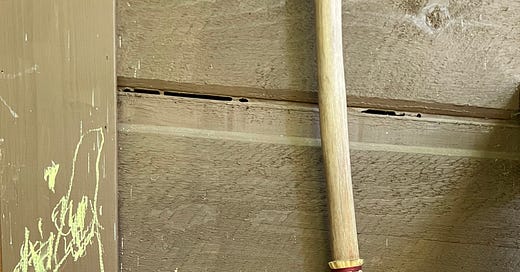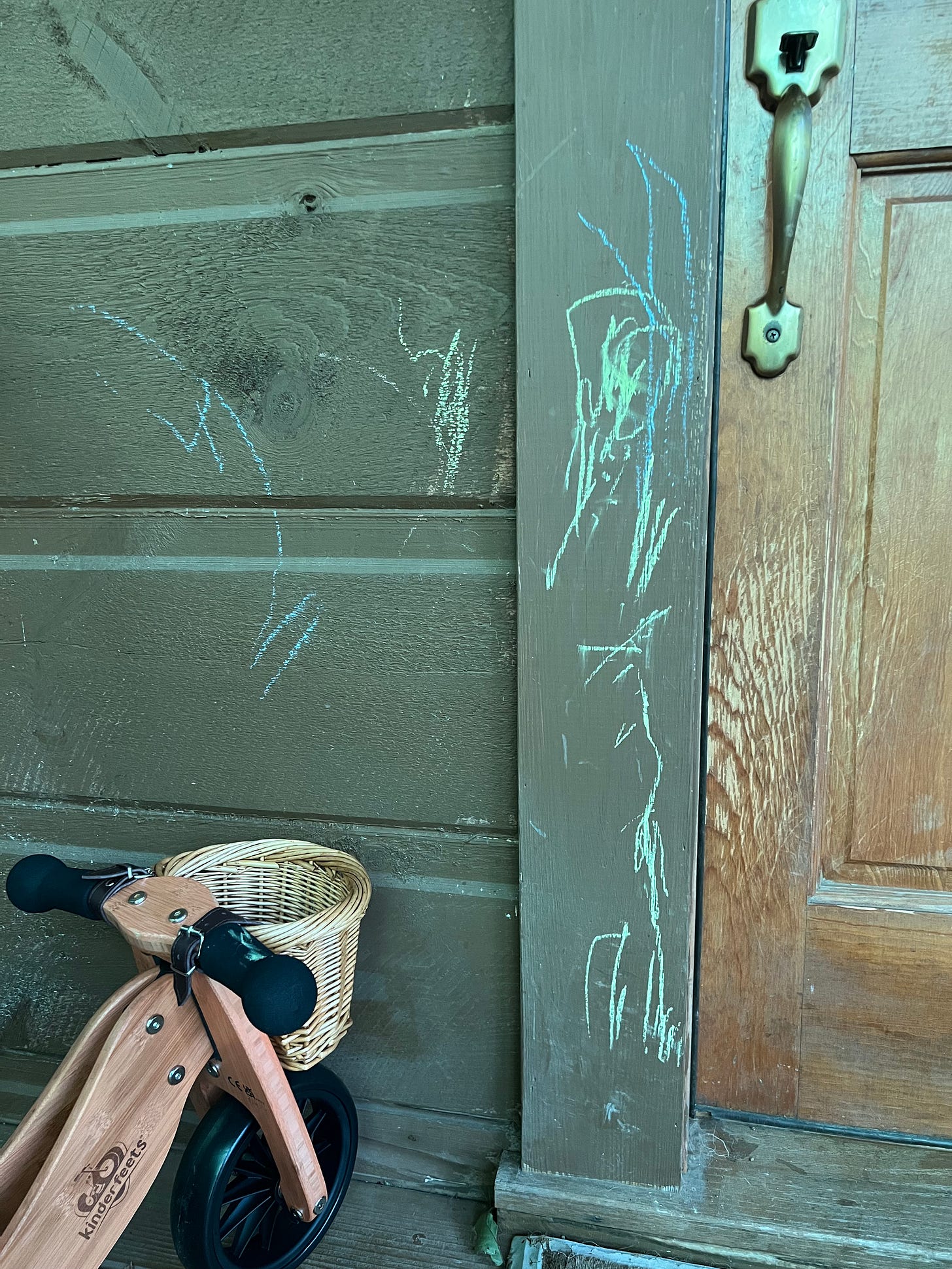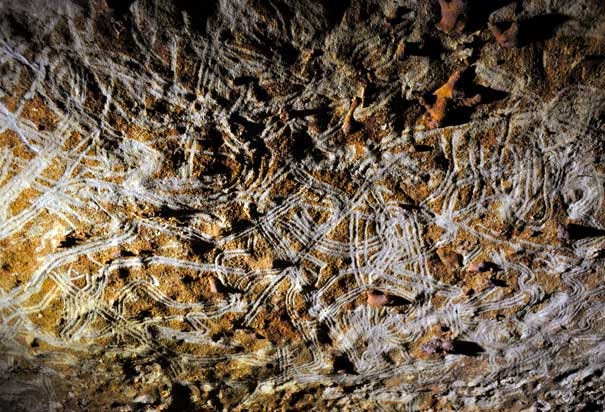My daughter has recently discovered the wonders of chalk. She calls it “painting” and delights in making every surface in the house her canvas. It’s certainly better than crayon, but still, we encourage her to take her artistic pursuits away from the drywall and out-of-doors. We keep a bin of chalk on the front porch now and she likes to amble out there while I’m cooking to paint.
The other day I stepped outside to straighten up while she was napping and noticed that she had made two inscriptions on either side of the door frame. They stopped me in my tracks.
Standing starkly on the dark wood they reminded me of the spiral carvings on the side-lying megaliths of Newgrange. The faded swirls of Pictish stones scattered through the Scottish countryside. The apotropaic pinwheels carved into the lintels of old churches and chapels. They felt holy, intentional, protective.
The wonder of the moment struck me. And I found myself thinking—how often do we write off children’s creations as scribbles when they are, in many ways, the first sigils?
Young children don’t usually have a rigid plan in mind when they “scribble.” The outpouring of color and line is simply an expression of their own bodily joy. It’s the deep pleasure of seeing something come into form. The spontaneous, uninhibited delight of pouring one’s energy into the world.
If I can let go of the part of me that need the walls blank, the form finished, the horizon line straight, I look at her scribbles and can feel the whisper of magic in every one of her swirls.
Sigils—symbols created to protect, invite or release— come from the Latin “sigillum”, meaning “seal.” It’s the same root of the English words “signature” and “sign”. Sigils are emblems of energy, invocations, and pathways. They are ways in which we can make energy manifest, bringing newness into the world.
So now, when I find a new scribble around the house, I stop to take in the spontaneous blessing of that sigil (even if it means needing to, eventually, come in afterward with a sponge). It’s my daughter’s signature, the sign she’s leaving in the world. And it’s a seal, an invocation, of something I need more of in my life.
Somewhere along the way, most of us lose the spontaneous human joy of being in a body. That unimpeded flow of creation, energy, and expression. We learn how to package our life force, to put it away in neat compartments, channeled towards achievable goals.
But the spontaneous sigils that come from a child’s hand are invitations to let go of all of that. To stop always needing to channel your energy into narrow bands of creation, and to remember how it feels to inhabit the freedom of your own body and life force.
To pick up a piece of chalk and let what comes out be an outpouring of your honest curiosity. Your delight in physical reality. The wave-pattern of your own unending energy.
How different would our culture be if the scribbles created by children became our sigils again?
For a long time archeologists studying the cave art of the Paleolithic largely ignored everything but the more recognizable forms of animals and humans, but the vast majority of cave is much less formalized. Most prehistoric caves are covered in a patchworks of swirls, turns, scribbles, and indented lines pressed into the cave walls called “fluting”. Now that archologists are taking a closer look, there’s evidence that many of these flutings and “scribbles” were, in fact, created by children.
In Rouffignac cave, known as the cave of a Hundred Mammoths, researchers have shown that the prolific, mind-expanding finger fluting created 13,000 years ago likely came from children, ages 2-5. Covering the walls and ceiling, the fluting created by these small hands appear deep inside the cave and so high on the walls, children would have been lifted by adults to drag their fingers through the soft clay of the ceiling.
Archeologists are realizing now that children were likely a large part of the creation of many of these sacred places. Their artistic magic was specifically included, bolstered, and imprinted into the holy places that were the Sistine chapels of their day.
Flutings at Rouffignac. Credit: Jessica Cooney / Leslie van Gelder.
When you look at pictures of these flutings, they move through you like water, like wind, like energy flowing unimpeded through the body and the land. Another word for these lines are “serpentines.” They are a capturing of what it looks like, what it feels like, to have the energy of life move through you. There is a power here, a power that is nascent, indigenous to the human condition, and one that we’re being asked to honor again.
So yes, even though I will eventually be wiping those chalk lines off the front door, and I’m not a huge fan of the blue fluting that somehow found its way all over our couch, I still take a moment every time I see them to pause.
There’s mystery here, there’s power, there’s magic.
There’s something she’s capturing that I’m in the process of remembering.
How to let life flow through me, with joy and abandon.
How to delight in the process of embodiment and creation.
How to see my own spontaneous outpourings— the projects started and discarded, the doodles, the daydreams, the things I often write off as scribbles in my own life— as sigils for another way of being.










I love this Asia, there is so much expression in us as children that tends to vanish as we get older from fear of judgement and criticism. When we connect to wisdom, we connect to that childlike ability to create anything from our imagination. I also think that children that are born now are already remembering their ancient wisdom, so finds ways to express it for all of us to take note.
I love this perspective! I’ve often seen my daughter drawing spirals and always wondered if there was an instinctive force at play... hadn’t thought of them as Sigils though! Magic! ✨